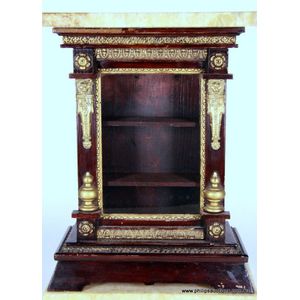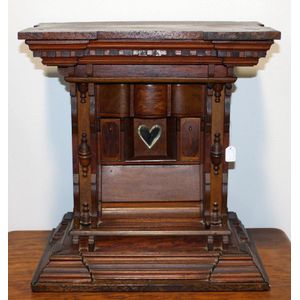Colonial Mottled Kauri Jewellery Cabinet with Dentil Cornice
You must be a subscriber, and be logged in to view price and dealer details.
Subscribe Now to view actual auction price for this item
When you subscribe, you have the option of setting the currency in which to display prices to $Au, $US, $NZ or Stg.
- Dentil Moulding - An architectural ornamental feature found on furniture, usually directly beneath the upper mouldings on a cornice. The timber is cut in a series of deep rectangular sections, alternatively raised and flat, like the crenellation on a castle battlement. In appearance not unlike a row of small teeth. From the latin "dens", teeth. Most commonly seen on bookcases, chests and cabinets, and less frequently on desks and wardrobes.
- Kauri - An evergreen conifer tree associated with New Zealand, but also grown in northern Australia, and islands around the Pacific rim including Borneo, Vanuatu and New Guinea. The timber is generally golden in colour, and straight grained without much knotting.
A by-product of the kauri tree was the kauri gum, the fossilised resin extracted from the tree. The gum was obtained through digging, fossicking in treetops, or more drastically, by bleeding live trees. Kauri gum was used in the manufacture of varnishes and other resin-based products, and also crafted into jewellery, keepsakes, and small decorative items.
Kauri forests were prolific in the north of the North Island of New Zealand. European settlers in the 1700 and 1800s realised that the timber from these tall trees with broad trunks would be ideal for ship building and construction and a thriving industry was established harvesting the kauri tree. The forests were substantially reduced, and now the remaining Kauri trees that grow in New Zealand are protected, and there are reserves in various areas of the North Island.
The remaining stands of kauri in New Zealand are under threat from "kauri disease", a microscopic organism that causes dieback in the trees, with vast tracts either dead or dying. - Cornice - The upper section of a high piece of furniture such as a bookcase, wardrobe or cabinet that sits immediately on the main structure. The cornice is usually decorated with a variety of architectural mouldings, worked either with a moulding plane or, from the later 19th century, by machine. The front and side of the cornice are mitred together, strengthened by glue blocks, and the back is generally a simple dovetailed rail to hold the structure together. Cornices are generally, though not always, fitted separately to the piece and are held in place either by screws sunk into the top board or by wooden corner blocks. A pediment may sit above the cornice, but sometimes the terms cornice and pediment are used interchangeably.
This item has been included into following indexes:
Visually similar items

A French walnut mirrored back hallstand. 214 cm high,98 cm wide.

A Colonial Australian cedar sideboard, full cedar secondaries, from the workshop of James Whitesides of Hobart, circa 1840, 148 cm high, 214 cm wide, 72 cm deep

A miniature Louis XVI style vitrine, later 19th century, with an alabaster top above a stepped cornice, a glazed door opening to velvet lined shelves, well decorated throughout with brass rosettes, pendant motifs and trims and upon a spreading base with an

Long case clock, arched glazed door with gilded and floral detail, Roman numeral dial, height 204 cm
